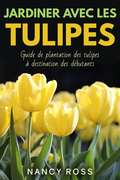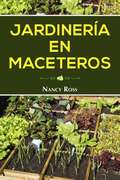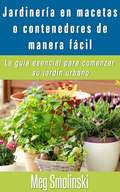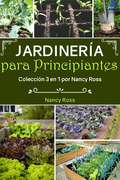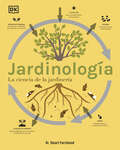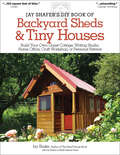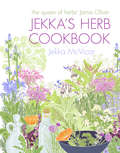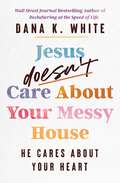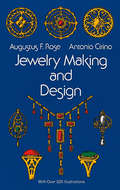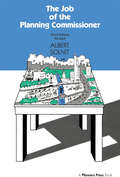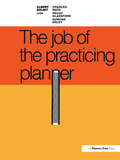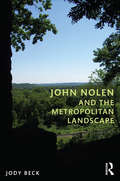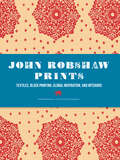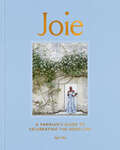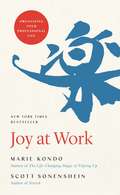- Table View
- List View
Jardiner avec les tulipes: Guide de plantation des tulipes à destination des débutants
by Nancy Ross Traductrice Floriane BalligeLes tulipes sont des fleurs qui comptent parmi les plus belles et dont les espèces sont les plus variées au monde. Ce guide de plantation des tulipes est une véritable bible pour les débutants désireux d'embellir leur jardin avec ces fleurs sublimes aux couleurs et aux formes éclatantes.
Jardinería Para Principiantes: Todo Lo Que Necesitas Saber Para Comenzar a Cultivar Hortalizas, Aromáticas Flores.
by Susan Wright¿Quieres saber como cultivar deliciosas hortalizas, aromáticas y hermosas flores en tu jardín? ¿Quieres hacer en jardín en tu patio pero no sabes cómo comenzar? ¿Sabías que la jardinería puede mejorar diferentes aspectos de tu salud? ¿Tienes planes en tu mente para tu jardín pero no sabes cómo concretarlos? ¿Has estado buscando información que te ayude a entender como cultivar plantas, y cómo prepararte para hacerlo bien? Si esto te resuena, ¡sigue leyendo!
Jardinería de Invernadero
by Nancy RossLa jardinería de invernadero puede ser una gran forma para extender tu temporada de cosecha y, a la vez, divertirte más con este hobby. Para aquellos que viven en climas norteños, es normal tener que lidiar con ciertos problemas, heladas tardías o temperaturas bajas durante los principios de primavera. A menudo esto implica que las semillas no podrán germinar con facilidad. Con un invernadero adecuado, esto no será un obstáculo, debido a que te proveerá de condiciones aptas para que las plantas puedan florecer. Con esta guía, podrás comenzar un invernadero a tu gusto. Empezaremos explicando lo básico: proceso para plantar, cuánta agua necesitarás para cada planta, la temperatura correcta, cómo elegir la tierra (sustrato), eliminar plagas de forma natural. Cuando estés listo, incluso un principiante podrá comenzar su propio invernadero en poco tiempo. Cuando estés preparado para extender tus temporadas de cultivo y para sacarle el jugo a tu invernadero, mejor lee esta guía, aprenderás todo lo que necesitas para cultivar cualquier planta que quieras, sin importar donde vivas.
Jardinería en Maceteros
by Nancy Ross¿QUIERES PARENDER LOS PROS Y CONTRAS DE LA JARDINERÍA EN MACETEROS? Aquí Tienes Una Vista Previa De Lo Que Aprenderás... Consiguiendo Maceteros Para Tu Jardín Creando Un Ambiente Apropiado para las Plantas de Maceteros Escogiendo el Tiempo Apropiado para Plantar Las Mejores Plantas para Crecer en Tu Jardín de Maceteros Tips para Ayudar al Crecimieto de Tus Plantas Y Mucho, Mucho, ¡Más! Aquí Tienes Una Vista Previa De Los Vegetales que Aprenderás a Cultivar... Lechiga Cebollas Tomates Zanahorias Rábanos Pepinos Frijoles (Porotos) Betabeles Vegetales Crucíferos Berenjenas Pepinos Y Mucho, Mucho, ¡Más!
Jardinería en macetas o contenedores de manera fácil
by Meg Smolinski Dahlia Deyanira Romero CastilloLa jardinería en macetas o contenedores es divertida, fácil, y es una buena manera de cultivar productos frescos casi todo el año. Esta guía ayudará a tanto principiantes como jardineros experimentados a obtener lo mejor de la jardinería en macetas con increíbles ¡consejos y trucos! Desde muy pequeña amé la jardinería, y siempre he estado fascinada con la idea que, con poco trabajo, buena tierra, agua y luz solar, puedes cultivar tu propia comida. He tomado esa fascinación y la he dejado crecer (juego de palabras) y ahora he creado este libro electrónico con los mejores consejos y trucos sobre la jardinería en macetas para ayudarte a iniciar tu propia jardín urbano hoy mismo. Ya sea que elijas la jardinería en macetas de vegetales o tus propias flores hermosas, puede ser una experiencia gratificante que incluso principiantes pueden iniciar con calma. En este libro aprenderas: 1. Entenderás el concepto de jardinería en macetas y cómo es la mejor forma para las personas de todas partes iniciar-- incluso las personas en ¡departamentos! 2. Seleccionar el tipo correcto de contenedores para tu jardín 3. Consejos de cultivo para asegurar que tus plantas no ¡mueran! 4. El cuidado correcto de un jardín urbano 5. Secretos de como mantener bello y prospero tu jardín en macetas Comienza hoy mismo tu propio jardin en macetas y cultiva tus propias flores, frutas y vegetales. Obten esta guía para iniciar con tu jardín ¡CORRECTAMENTE!
Jardinería para Principiantes: Colección 3 en 1 por Nancy Ross
by Nancy Ross¿DESEAS APRENDER LOS PORMENORES DE JARDINERÍA PARA PRINCIPIANTES? Aquí Está Un Anticipo De Lo Que Aprenderás Sobre La Jardinería De Contenedores… •Conseguir los Contenedores para tu Jardín •Crear un Buen Entorno para las Plantas de Contenedor •Elegir el Momento Correcto para Plantar •Las Mejores Plantas para Cultivar en tu Jardín de Contenedores •Consejos para Ayudar a que tus Plantas Prosperen •¡Mucho, Mucho Más! Aquí Está Un Anticipo De Lo Que Aprenderás Sobre La Jardinería De Invernadero… •Montar un Jardín de Invernadero •Cultivar Plantas en tu Invernadero •Formas de Controlar el Clima en tu Invernadero •Algunos de los Mejores Métodos para Plantar en el Invernadero •Cómo Deshacerse de las Pestes •¡Mucho, Mucho Más! Aquí Está Un Anticipo De Lo Que Aprenderás Sobre La Jardinería Vertical… •Montar la Base que Necesitas en tu Jardín •Trabajo de Mantenimiento de tu Jardín Vertical •Hacer Espacio para las Plantas •Seleccionar las Plantas Correctas •Algunos Consejos para tu Jardín Vertical •¡Mucho, Mucho Más!
Jardines (¡Arriba la Lectura!, Level I #10)
by Heather Hammonds Ben SpibyNIMAC-sourced textbook. ¡Cuesta mucho trabajo mantener un jardín! Pero los jardines son el hogar de animales e insectos, y son lugares hermosos. ¿Qué trabajos importantes puedes hacer en el jardín?
Jardinología (The Science of Gardening): La ciencia de la jardinería
by Dr. Stuart FarrimondUn libro de jardinería diferente que explica la ciencia detrás de la jardinería de forma visual y clara.¿El mundo de la botánica y la jardinería te parecen un misterio? Las guías de jardinería al uso tienden a dar gran cantidad de instrucciones y consejos, pero rara vez aportan explicaciones sobre el por qué. ¡No te preocupes! El Dr. Stuart Farromond arroja luz sobre todas esas preguntas que siempre te has hecho y te explica lo que sucede en tu jardín desde un enfoque científico.La guía botánica definitiva para entender los secretos de la horticultura y la floricultura como un profesional:Escrita con un lenguaje accesible y libre de tecnicismos en formato pregunta y respuesta. Con explicaciones claras, apoyadas por gráficos y esquemas para ilustrar los conceptos de forma visual.Estructurado en torno al ciclo de vida de un jardín, desde los primeros brotes hasta el momento de la poda.Explica los beneficios de la jardinería para la salud mental y el medio ambiente.Un práctico manual de jardinería con explicaciones y consejos avalados por la ciencia, que te ayudará a comprender mejor cómo se comportan las plantas, desmitificar creencias y descubrir las bases y avances de la horticultura moderna. ------------------------The only book to explain the science behind gardening practice in a simple and visually accessible way.The world of gardening can be a mystifying place, with so many instructions to follow and often little explanation as to why. Dr. Stuart Farromond casts his scientific eye over a typical year in the garden to answer all the horticultural questions you&’ve ever wanted the answer to. This great gardening book provides a shortcut to decades of gardening experience by explaining the science behind how a garden grows, featuring: An accessible guide structured around the life cycle of the garden, taking you from first shoots to pruning for renewal. An accessible Q &A format, with stats and infographics to bring the story to life, as well as long-held gardening myths are exploded by new science. Every way to greener fingers has an action point so that you can understand the science, apply your gardening practice, and enjoy a flourishing garden.From hands-on, practical advice, to an exploration of the mental health benefits of gardening, while also covering topics such as the positive impact gardening can have on the earth during a time of climate crisis in between, The Science of Gardening debunks myths and reveals the latest science only taught at horticultural college. As a passionate newcomer to gardening, daunted by the mountain of often conflicting advice in gardening manuals, Dr. Stu has set about testing the scientific basis of so much conventional wisdom and practice so you too can garden like a pro.
Jay Shafer's DIY Book of Backyard Sheds & Tiny Houses: Build Your Own Guest Cottage, Writing Studio, Home Office, Craft Workshop, or Personal Retreat
by Jay ShaferFrom the bestselling author of The Small House Book, comes a collection of designs for tiny homes with &“instant curb appeal.&” (The New York Times) From internationally recognized small living expert Jay Shafer, who has been featured on CNN, Oprah, Fine Homebuilding, and This Old House, a revised edition of his bestselling book, Tumbleweed DIY Book of Backyard Sheds and Tiny Houses. Ranging in size from 100 to 120 square feet, these tiny backyard buildings can be used as guest cottages, art or writing studios, home offices, craft workshops, vacation retreats, or full-time residences. This book is filled with photos, elevation drawings, and door/window schedules for constructing six of the handsome little buildings, plus an extensive how-to set of instructions that can be applied to any backyard building project. This revised edition contains many new photos of buildings designed by Jay Shafer. Praise for Jay Shafer and Tumbleweed Tiny Houses: "... guru of the small house movement." —John Blackstone, CBS "Move-in ready gems." —Better Homes and Gardens &“Astounding." —Oprah Winfrey "A visionary designer ..." —Domino Magazine "100 square feet of bliss." —Thelma Guiterrez, CNN
Jekka's Herb Cookbook: Foreword by Jamie Oliver
by Jekka McVicarJekka McVicar's passion for herbs has evolved over 40 years. In this, her first cookery book, 'queen of herbs' Jekka offers over 250 original recipes using simple garden herbs, along with tips for growing and maintaining them.Herbs have long been a part of British culinary history, yet few people utilise them to their full potential. Incredibly versatile, not only do herbs impart flavour, aroma and texture to dishes, they are extremely beneficial to our health. Much more than a cookbook, Jekka's Herb Kitchen features 50 herbs with a chapter and recipes devoted to each - Jekka's huge knowledge of each herb's history, cultivation and medicinal and culinary uses is unsurpassed. Her recipes are simple and economical - she shows how herbs can transform a cheap cut of meat, enliven a pasta sauce, and even add delight to desserts. She also offers suggestions for how best to combine herbs and what parts to use, gives ideas for using up a glut of a specific herb, and advises on how to preserve your herbs for the winter months. Moreover, this volume is a family affair - many of Jekka's recipes are inspired by her grandmother and mother, and the stunning illustrations are by Jekka's daughter, Hannah McVicar. With colour photographs throughout, this is a unique and beautiful volume from the UK's foremost authority on herbs.
Jesus Doesn't Care About Your Messy House: He Cares About Your Heart
by Dana K. WhiteThe phrase &“cleanliness is next to godliness&” isn&’t found in the Bible. Your house can never be good enough to please God—not because you can&’t scrub it or declutter hard enough, but because that is never what He was looking for in the first place. Join Dana K. White, author of Decluttering at the Speed of Life, as she works through removing the shame associated with having a messy home and reveling in the grace and love of our Savior.This book is for you, if no matter how competent you feel in other parts of your life, you still feel overwhelmed and defeated by your messy home. While it&’s true that keeping a clean and organized living space can contribute to a sense of peace and well-being, it should never be equated with your worth, moral standing, or what Jesus thinks about you. Dana K. White, trusted by millions for her no-holds-barred cleaning confessions and practical decluttering method wants to:remove any shame or identity crisis associated with disorganizationhelp you understand God's love and purposeful design for you that is much bigger than any mess in your house. Sharing relatable stories, biblical teaching, and practical life application, Dana will help you find a sense of freedom, acceptance, and a deeper understanding of God's love and purpose for you and your house.
Jewelry Making and Design: An Illustrated Text Book For Teachers, Students Of Design, And Craft Workers In Jewelry
by Antonio Cirino Augustus F. RoseThe ancient, highly skilled craft of manipulating gold, silver, precious, and semi-precious stones into jewelry is here set forth in a practical text. The authors take you through a graded series of problems, progressing from simple to complex pieces, teaching you all you need to know along the way.Making a pierced brooch is the first problem. You learn to affix a tracing of the design to the metal, and to handle a center punch, saw frame and saw, needle file and flat-round file, and emery cloth. This first problem is fully illustrated, as are all the problems, with 53 different design ideas, as well as photographs of the tools and processes involved. Subsequent problems teach you to make brooches set with stones, chased and repoussé brooches, wire pendants, rings with four different types of settings, chains, and cuff links. Executing these pieces teaches you the processes of soldering, pickling, using a gas jet and blow pipe, making a plain and shouldered bezel, annealing, enameling, making a mold for casting, and much more.Following the section on the making of jewelry, the authors turn to a discussion of the aesthetics of jewelry design. They suggest sources in nature and in art for creative ideas and motifs, and give helpful methods for developing these into designs suitable for various types of jewelry pieces.The authors, both formerly of the Rhode Island School of Design, animate every line of the text with the knowledge that only long experience in the craft and in teaching the craft can give. For many years, beginning and experienced crafters have kept this authoritative text beside them, using it to avoid costly mistakes and to save many hours of trial-and-error experimentation.
Jihadists and Weapons of Mass Destruction
by Gary Ackerman Jeremy TamsettExplores the Nexus Formed When Malevolent Actors Access Malignant MeansWritten for professionals, academics, and policymakers working at the forefront of counterterrorism efforts, Jihadists and Weapons of Mass Destruction is an authoritative and comprehensive work addressing the threat of weapons of mass destruction (WMD) in the hands of jihadists,
Job of the Planning Commissioner
by Albert SolnitA popular and practical guide on how to be an effective planning commissioner. Filled with checklists and outlines, it's both a good introduction and a handy reference. Includes a training checklist for new commissioners, criteria for keeping a master plan in working order, lists of tools to guide growth, advice on how to deal with professional staff, and dos and don'ts for conducting successful public meetings. This edition sharpens the focus on how commissioners and their staffs can operate under four core principles for planning commissioners: citizen involvement, smaller is better, living in a market-driven system, and orderly growth.
Job of the Practicing Planner
by Albert SolnitThis practical handbook demystifies development review. It explains the tools of local regulation and the technical, bureaucratic, and organizational skills planners need to be effective. Solnit shows how to work with developers, evaluate projects, and use fiscal impact analysis. Includes a section on planning ethics, checklists, and tips on negotiating. Chapters by contributing authors cover subdivision plats, site plans, appearance codes, and writing zoning reports. The Job of the Practicing Planner is a perfect introductory textbook in classes for planners and a practical handbook for people already on the job.
Joe's Allotment: Planning and planting a productive plot
by Joe SwiftWith hardly any previous veg-growing experience and even less time, when Gardener's World design guru Joe Swift decided to take on a 250 sq metre allotment in north London, some people thought he was mad. But with hard work and dedication, in less than a year Joe created his very own urban oasis and a source of delicious, fresh, organic produce for himself and his family.In this book Joe takes us through every stage of his education as an allotment gardener, from putting his name on the council waiting list to harvesting his first crops. He reveals everything he's learned about acquiring a plot, clearing the site, planning the beds, and planting, nurturing and protecting his fruit and vegetables. All the techniques he has mastered are described and illustrated, step by step.Joe also introduces us to his Veg Heroes like Monty Don and Geoff Hamilton - fellow plot-holders with years of experience and the crops to show for it - who inspired Joe to take up veg growing in the first place. And he shares with us his enjoyment of allotment gardening, the combination of hard work, fresh air and a sense of community that makes his plot such a special place to be.Whether you are an established allotment gardener or are thinking of putting your name down for a plot, Joe's Allotment will provide you with a wealth of advice and inspiration.
Joey Green's Amazing Pet Cures: 1,138 Simple Pet Remedies Using Everyday Brand-Name Products
by Joey GreenFrom the man who knows how to fertilize houseplants with Jell-O and give someone a dry shampoo with Quaker Oats comes the first book of pet care tips that tackles everyday pet illnesses, quirky behaviors, and animal smells and stains by tapping into the power of brand-name products.The ever-inventive Joey Green presents fun and offbeat remedies for a wide range of pet troubles, from bad breath and skunks to hot spots and ticks. Who would have guessed that ChapStik stops a nail bleed or that Listerine can quell itching? Why not forego expensive and toxic flea sprays and use Dawn dishwashing liquid or Johnson's Baby Powder as a treatment instead?Even though these tips sound quirky (use Smirnoff vodka to clean your pet's ears?), they really do work because many brand-name products contain soaps, degreasers, emollients, and moisturizers to soothe, clean, dissolve, and heal quickly and safely. Joey Green's Amazing Pet Cures makes a great gift for pet lovers and is a practical guide for anyone looking for simple and easy shortcuts to live the good life with a pet.
Joey Green's Cleaning Magic: 2,336 Ingenious Cleanups Using Brand-Name Products
by Joey GreenFrom the guru of discovering extraordinary uses for brand-name products come brand-new ways to make cleaning, organizing, and decluttering quick, easy, and a lot more funThe public is endlessly fascinated by quirky and offbeat uses for their favorite products and, this time around, Joey Green tackles household chores with his pantry full of cleaning power. Green's easy and effortless tips and tricks show how to scrub, deodorize, shine, and remove stains with products already in the house.While Green's suggestions may sound implausible, they are, in fact, highly effective. Most products on the market today are a complex mix of lubricants, abrasives, and cleansers, giving these brand-name products plenty of power to clean, dissolve, and fix in the most unexpected ways. Joey Green's Cleaning Magic offers clever ways to make household items do double duty, like using a slice of Wonder Bread to clean up tiny shards of glass from a kitchen floor—just pat it flat against the floor and toss it away—and wiping away the gunk from the bottom of an iron with Purell. This practical, useful, funny, and entertaining volume includes thousands of incredibly simple ways to clean up every room (and dusty corner) in the house.
Joey Green's Kitchen Magic: 1,882 Quick Cooking Tricks, Cleaning Hints, and Kitchen Remedies Using Your Favo rite Brand-Name Products
by Joey GreenFrom the guru of brand-new uses for brand-name products come ideas and tips for culinary fun, cleaning shortcuts, and kitchen cabinet remedies Joey Green has fascinated readers for more than a decade with his quirky and innovative tips to make domestic engineering a lot more fun. Now fans will be completely intrigued and entertained by Joey's kitchen--and pantry-focused ideas, like using Canada Dry Club Soda to buff stainless steel appliances and flexible fabric Band-Aids as labels for frozen foods. Filled with time- and money-saving ideas, Joey Green's Kitchen Magic offers clever ways to make household items do double duty, like using ReaLemon for revitalizing wilted asparagus, L'eggs Panty Hose (clean, of course) for removing corn silk, and Oral-B Dental Floss for slicing layer cake. He shares unusual ideas for kitchen troubles, like stirring in Jif Peanut Butter to save burnt gravy and using Efferdent to clean the coffeepot. Joey even tosses in home remedies from the kitchen (soothe a blister with Carnation Nonfat Dry Milk) and simple recipes (try Slow-Cooker Brisket with a Coca-Cola marinade). Whether it's a quick fix (Eggo Waffles for hot dog buns, anyone?) or an emergency substitution (Bounty Paper Towel for a coffee filter), there are loads of useful and entertaining tips for making the most of brand-name purchases.
Joey Green's Magic Health Remedies: 1,363 Quick-and-Easy Cures Using Brand-Name Products
by Joey GreenHome remedies remain an appealing alternative to costly doctor visits—they're effective, inexpensive, and ideal for everyday illnesses and injuries that don't require hands-on medical care. When brand-name product guru Joey Green tackles a subject like home remedies, readers can be found reaching into their closets, cupboards, and pantries for their favorite products to cure what ails them. From relieving a migraine with Dole Pineapple Chunks, treating stinky feet with Clearasil, and soothing an insect bite with Colgate Toothpaste, Joey Green's Magic Health Remedies is packed with reliable, user-friendly cures for everything from acne and calluses to morning sickness and toothaches—121 conditions in all. Joey divulges that many products have special, never-before-revealed qualities not found on the label and, with a little ingenuity, can be used to treat minor health issues and conditions.There's compelling evidence for experimenting with off-label uses—like when hay fever strikes, a little McCormick Ground Turmeric in a glass of water brings relief in 15 minutes; the bioflavonoids in the spice are antioxidants that suppress histamine production. Who knew? Well, Joey knows and now he's bringing fast relief (and lots of fun) to health care at home!
John Nolen and the Metropolitan Landscape
by Jody Beck"A model city, the hope of democracy" – John Nolen on his suggested plans for Madison, Wisconsin This book connects John Nolen's political and social visions with his design proposals by analyzing his extensive writings, personal correspondence and some of his most significant works. While John Nolen is best known as a city planner, he trained as a landscape architect and used the titles 'landscape architect' and 'city planner' interchangeably throughout his career. A prolific practitioner, he was engaged in nearly 400 projects throughout the United States between 1905 and 1936, including town planning, industrial housing, state and city parks, new towns and regional planning. Focusing particularly on several projects central to Nolen’s career including Madison (WI), Mariemont (OH), Venice (FL) and Penderlea (NC), Beck investigates the ideologies that underpinned Nolen’s work. This is a rare look at a key figure in the development of 20th century American cities.
John Robshaw Prints: Textiles, Block Printing, Global Inspiration, and Interiors
by John RobshawDesign enthusiasts and armchair travelers will love circling the globe with celebrated textile designer John Robshaw. From batiks in Java to ikats in Thailand and indigo printing in India, Robshaw reveals the lush inspiration behind his signature style while highlighting step-by-step block printing techniques from local artisans and masters. Robshaw provides a rare glimpse into his creative process, wherein he blends traditional methods with his own painterly style for entirely unique creations, and shares tips for incorporating textiles into any space. Brimming with beautiful photographs of covetable textiles, far-flung destinations, and eye-catching interiors, this luxe fabric-covered book is an eclectic visual tour of the rich tradition of textile printing.
Joie: A Parisian's Guide to Celebrating the Good Life
by Ajiri AkiEmbrace the joy of Paris wherever you live with American expat Ajiri Aki, founder of the French lifestyle brand Madame de la Maison.&“More than being a terrific guide to the city, it&’s a thoroughly comprehensive guide to better living.&”—Chioma Nnadi, editor of VogueThe French are known for their joie de vivre—celebrating the simple things—a philosophy that tastemaker Ajiri Aki embraced all of her American life. As a child, she frequently tried to convince her Nigerian-Jamaican mother to pull out the fine china for everyday meals or when hosting friends. Her mother always said she was waiting for a special occasion, which sadly never came before she passed away when Ajiri was only twelve. Ajiri promised herself she would never hesitate to use her treasured pieces. When she moved to Paris, France, as an adult, she learned how central that idea is to French life, and she also began to absorb other essential lessons from her new friends: treat yourself to fresh flowers just because, take time to source the best baguette, and perhaps most importantly, enjoy être—just being.In this beautifully photographed volume of everything French, Ajiri shares what she&’s learned about living in Paris—from hosting the perfect apéro (happy hour) to lingering around town like a flâneur (loafer) to thrifting for antiques at the market. While exploring the prettiest cafes and shops, you&’ll be inspired to reclaim your right to leisure as the French have, so you, too, can savor the spontaneous, joyful moments that happen every day.
Joinery, Joists and Gender: A History of Woodworking for the 21st Century
by Deirdre VisserJoinery, Joists and Gender: A History of Woodworking for the 21st Century is the first publication of its kind to survey the long and rich histories of women and gender non-conforming persons who work in wood. Written for craft practitioners, design students, and readers interested in the intersections of gender and labor history—with 200 full-color images, both historical and contemporary—this book provides an accessible and insightful entry into the histories, practices, and lived experiences of women and nonbinary makers in woodworking. In the first half the author presents a woodworking history primarily in Europe and the United States that highlights the practical and philosophical issues that have marked women’s participation in the field. Research focuses on a diverse range of practitioners from Lady Yun to Adina White. This is followed by sixteen in-depth profiles of contemporary woodworkers, all of whom identify fine woodworking as their principal vocation. Through studio visits, interviews, and photographs of space and process, the book uncovers the varied practices and contributions these diverse artisans make to the understanding of wood as a medium to engage spatial, material, aesthetic, and even existential challenges. Beautifully illustrated profiles include Wendy Maruyama, one of the first women to earn an MFA in woodworking in the US; Sarah Marriage, founder of Baltimore’s A Workshop of Our Own, a woodshop and educational space specifically for women and gender non-conforming makers; Yuri Kobayashi, whose sublime work blurs boundaries between the worlds of art and craft, sculpture, and furniture; and Folayemi Wilson, whose work draws equally on African American history and Afrofuturism to explore and illuminate the ways that furniture and wood traditions shape social relations.
Joy at Work: Organizing Your Professional Life
by Marie Kondo Scott SonensheinDeclutter your desk and brighten up your business with this transformative guide from an organizational psychologist and the #1 New York Times bestselling author of The Life-Changing Magic of Tidying Up.The workplace is a magnet for clutter and mess. Who hasn't felt drained by wasteful meetings, disorganized papers, endless emails, and unnecessary tasks? These are the modern-day hazards of working, and they can slowly drain the joy from work, limit our chances of career progress, and undermine our well-being.There is another way. In Joy at Work, bestselling author and Netflix star Marie Kondo and Rice University business professor Scott Sonenshein offer stories, studies, and strategies to help you eliminate clutter and make space for work that really matters.Using the world-renowned KonMari Method and cutting-edge research, Joy at Work will help you overcome the challenges of workplace mess and enjoy the productivity, success, and happiness that come with a tidy desk and mind.
